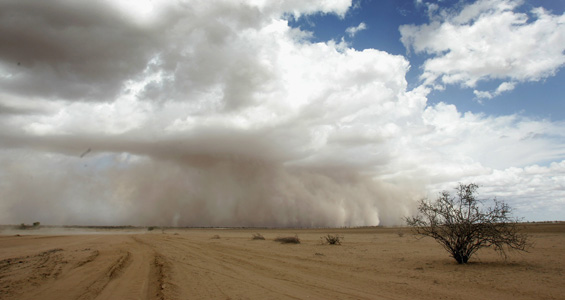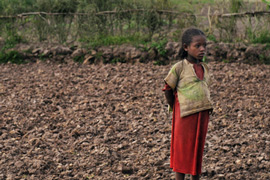Starvation looms in Horn of Africa
With subsidies cut from global charities, aid shortages have left many hungry.

 |
| Dust storms and drought have left many in the Horn of Africa at risk of starvation [GALLO/GETTY] |
Rising food prices, drought, lack of sustainable infrastructure and conflict are contributing to increased hunger in the Horn of Africa and in some regions increasing the likelihood of acute malnutrition and famine.
In Kenya’s north, for example, it has been two months since food aid reached the Turkana tribe pastoralists. The effects of three failed rain seasons and no aid is evident everywhere.
Keep reading
list of 4 itemsCould shipping containers be the answer to Ghana’s housing crisis?
Thousands protest against over-tourism in Spain’s Canary Islands
Holding Up the Sky: Saving the Indigenous Yanomami tribe in Brazil’s Amazon
The situation is further exacerbated by the sale of family assets like livestock to purchase food, and even the mass movement of families and villages in search of sustenance.
A shortage of aid caused by the global financial crisis is also hampering the activities of international agencies.
The world food programme says the situation in Kenya has become dire; more than eight million Kenyans are in need of aid, but assistance is only reaching 2.4 million of them.
In a sleepy village on the edge of Lodwar town, the drought has taken its toll on the young and elderly. Seventy-five-year-old Narputei Erait and her impoverished neighbours have been forced to depend on wild palm fruit for a living.
Her seven-year-old orphaned grandson collects the wild fruit for them whenever his energy permits.
I watched as the elderly ladies pounded the wild fruits to remove the outer covering before chewing it with obvious relish.
“I don’t know why God is keeping me alive in the midst of all this suffering,” Nepurtey said.
Distraught and hungry
 |
| Aid to the Horn of Africa has been severely affected by the global financial crisis [AFP] |
We took a four-hour drive from Narputei’s village to the Turkana tribe’s settlement of Lokoriam where there are more heartrending tales of hunger and need.
The young men left the settlement months ago in search of greener pastures for their livestock, leaving only women, a few elderly men and children behind.
The men took the cattle with them to avoid raids from neighbouring tribes who often attack to replenish their depleted livestock.
The men are unlikely to return and the women will be forced to resort to their own means to keep themselves and the children alive.
“We may be hungry, but we won’t die while there are wild fruits,” the women sing as they search for poisonous berries that have to be boiled for nearly a whole day before they can be eaten.
“If you eat the berries raw, you will die,” Ikeny Lomkuny says. “I have seen several people die and many get severe stomach pains.”
Severe drought
| In depth |
In neighbouring Ethiopia, a massive crop failure in the Southern part of the Country has also led to rising malnutrition.
A severe drought is wreaking havoc in Konso, an area once considered the breadbasket of the country.
More than 90 per cent of the people are small scale farmers who usually survive on harvests of maize and root crops which are harvested twice a year. But for the third consecutive year, most farms in Konso will produce negligible yields.
“I have never faced such bleak prospects in my life,” says Elaiya Halake, a 70-year-old father of 12 children.
“Relief from the government is all we have to depend on but that is never enough. Unless we get proper rains our lives are in danger,” he added.
In Konso, malnutrition is rising and fast. In the district’s ill-equipped and under-staffed health centre, the feeble cries of children have become deafening. At the clinic’s stabilisation centre sick children are brought in daily.
A malnourished child with peeling skin catches my attention. Doctors told me he suffers from a condition known as Kwashiorkor. His body swells and then his skin cracks wherever the swelling subsides.
It is the weakest in the community, such as this child, who are most at risk.
“With no harvest expected any time soon I now fear for the lives of adults,” Geiyeto Gara, the centre’s medical coordinator, said.
Last week Ethiopia’s Government announced that at least six million people living in drought affected parts of the country were in urgent need of assistance. But aid agencies put the figure closer to 10 million people.
Migration to towns
Meanwhile, in Djibouti consecutive and lingering droughts are threatening the lives of the hardened nomads who for centuries have trudged the rocky and barren landscape.
Many pastoralists are forced to move with the livestock in search of water and pasture and at times travel in circles only to end up right back where they started.
Many don’t give up till their livestock is decimated. It is only then that they move to urban areas in search of a new life as casual labourers.
In recent years, the capital and most of Djibouti’s urban areas have become surrounded my informal settlements established by those pastoralists who have escaped the drought-stricken areas.
Omar Muhumed was forced to settle in Holhol town 10 months ago when his livestock was wiped out. He told me that life in Holhol was not any better.
“I have nothing to give my wife and seven children. Four of them were taken in by relatives who took pity on me,” he said.
Omar now lives in a small shack made of old clothes and sticks – nothing that can save him and his family from rain and the ferocious desert winds.
As the Al Jazeera crew left I couldn’t help but turn to look at Omar and his family as they huddled together outside their hut.
They are the newest of the Horn of Africa’s swelling number of environmental refugees who are at continued risk of starvation and possible death.

